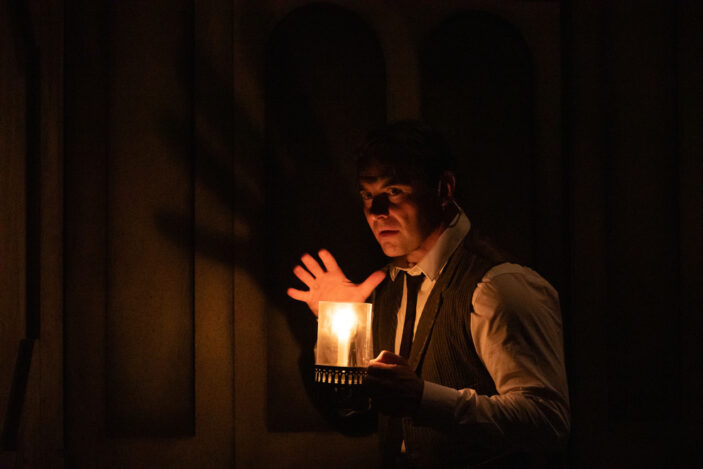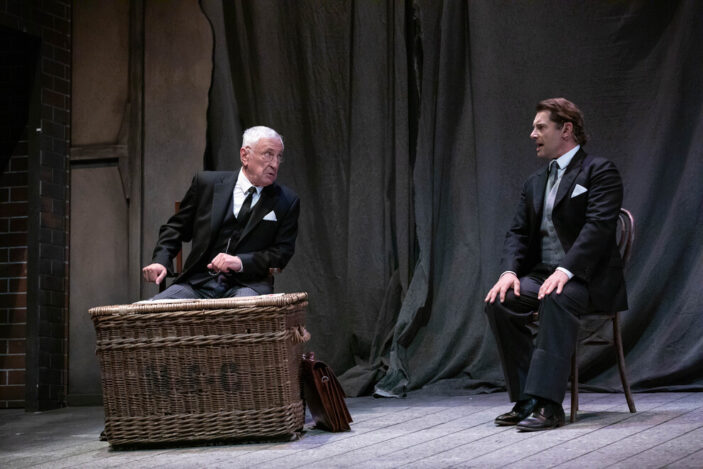
Prepare for the most spine-chilling ghost encounter of the year. Susan Hill’s acclaimed gothic horror tale hasn’t gone dull with age, surviving through Stephen Mallatratt’s remarkable adaptation, which has lived on London’s West End for over 30 years. Bringing its ghostly horrors to Melbourne, The Woman in Black is a thrilling exploration of terror that employs the riveting duo of John Waters and Daniel MacPherson as its two performers.
This two-man production tells the story of a lawyer, Arthur Kipps (John Waters), whose life has been upended by a curse he believes began when he encountered the spectre of a Woman in Black. With a strong desire to tell his story to the world, he employs a young actor (Daniel MacPherson) to help exorcise the fear that has gripped his soul.
Upon entering the theatre, a dark and gloomy atmosphere fills the stalls. The raked stage looms ahead, with its minimal props and ominous charcoal grey curtains rising beyond the ceiling. Waters enters at stage right to resounding applause, and the terror begins. Well, the terror begins following a tonal adjustment. As the production introduces us to Kipps and the Actor, before their horrific retelling begins, it leans heavily on their contrasting personalities, bringing about a number of laughs. Laughter isn’t what you’d initially expect, but it comes naturally as Kipps’ awkward, bumbling persona clashes with the charismatic optimism of the Actor. This clever subversion and calming of the nerves eases everyone into a sense of calm before the chills settle in.
Once the retelling of Kipps’ haunting experiences kicks off, the true horrors of Susan Hill’s timeless tale begin to take hold. This is a gradual build, one focused on instilling terror and unease within its audience through a clever use of sound design and lighting. It doesn’t come out guns blazing, it adopts a slow pace that effectively keeps its audience on the edge of its seat. It’s this approach to horror that’s the most impactful in generating scares, holding on to that tension while jumpscares would otherwise release that grip.
For anyone wondering whether it’s actually a horrifying affair, rest assured that there’s scares aplenty spread throughout both acts of the production. From the more subtle silhouettes of a slow-moving spectre to the loud shrieks that overload the senses, each method had spines tingling across the entire Athenaeum Theatre. There’s a couple of moments in which a thick fog seeps into the crowd and obscures all vision of the stage, creating widespread unrest and fear in the audience for what lies within it. It’s perhaps the best use of fog in a stage production, contributing to the cold, chilling atmosphere and making for a memorably terrifying moment.

Sound design is an element crucial to the immersion of the story and effectiveness of the scares, as is dictated by MacPherson’s Actor to Kipps while getting ready for their own production. Sebastian Frost has done an incredible job in executing his sound design to perfection, used in key moments to enhance the otherwise minimal staging. From the sound of horse hooves to a bustling streetscape, it’s constantly used to great effect. As the horrifying chaos amplifies in the second act, the sound gets increasingly more crucial, instilling edge-of-seat chills in the entire audience through ominous, supernatural tones.
In a production that’s largely shrouded in darkness, lighting becomes an important component by default. Minimal as it may be, it gets progressively darker through the play as the haunting atmosphere takes over. It’s used best when illuminating a section of the stage and leaving the rest drenched in black – leading eyes to wander into the darkness and wonder whether there’s something there or not. It’s that suggested presence that’s at times more terrifying than the ensuing scare. Whether it be a spotlight, flashlight or candle, each different method of lighting the stage is effective in enhancing the terror. By far the best use of lighting is in the moments set behind the charcoal grey curtains. When that space is illuminated, we get a hazy look at what’s going on, and it’s wonderfully gripping.
What makes this production so riveting is seeing John Waters and Daniel MacPherson go back and forth. Watching them command the stage is a captivating affair, they complement each other perfectly with stellar performances that fit their respective characters. As this is essentially a play within a play, Waters plays a revolving door of characters, shifting outfits, accents and demeanours to represent everyone MacPherson comes in contact with as a young Kipps. As much as he nails every one of his roles, it’s the brief instances in which he’s narrating as Kipps that are the most chilling. The raw, gravelly nature of his voice gives off that vibe of telling spooky stories by the campfire, making the hairs stand up on the back of your neck.
MacPherson has an equally tall order as for the majority of the play he has the stage to himself, tasked with selling the terror a young Kipps is experiencing while staying at the Eel Marsh House. The delivery of his dialogue is wonderful, and the way he reflects fear through a shaky voice and gaunt demeanour is a sign of a brilliant performer. Because of this, it’s also easy to tell when he transitions from portraying the Actor to ‘Kipps as portrayed by the Actor’.
If it’s a dose of gothic horror you’re after, put down the remote and witness the original spine-chiller, Susan Hill’s The Woman in Black. It takes a minute for the narrative to begin to take shape, but once it becomes clear how this terrifying experience is going to be told, it doesn’t break stride. Offering suspense and edge-of-seat thrills aplenty, this play turns Melbourne’s Athenaeum Theatre into a pressure cooker of atmospheric chills. Will you catch a glimpse of the Woman in Black herself? Witness Arthur Kipps’ harrowing story and uncover the horrors that plague the Eel Marsh House.
FOUR AND A HALF STARS (OUT OF FIVE)
The Woman in Black is now playing at the Athenaeum Theatre in Melbourne through to July 6th, 2024. The terrifying tale then moves to Canberra, Wollongong, Newcastle and Sydney. For more information and to purchase tickets, head HERE.
Reviewer attended on Friday June 14th, 2024
Photo credit: Justin Nicholas
